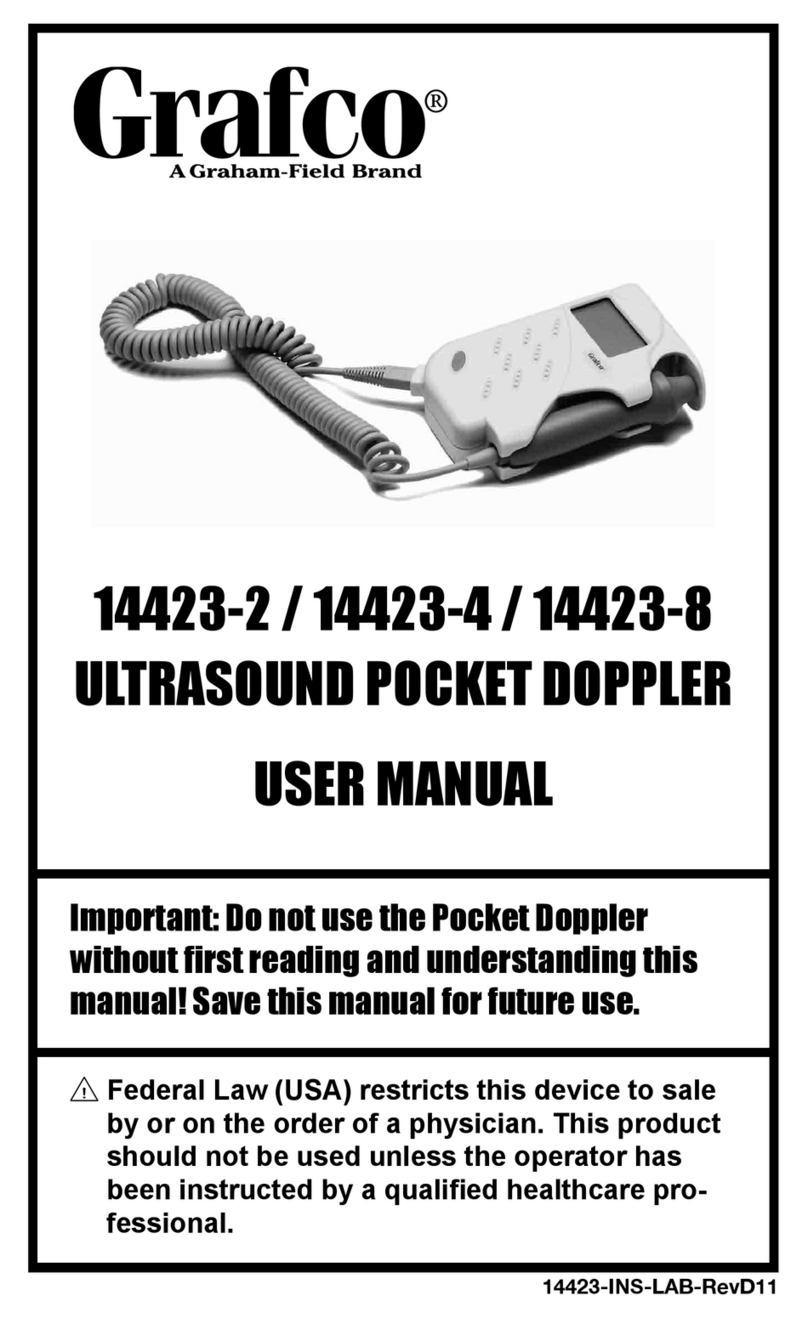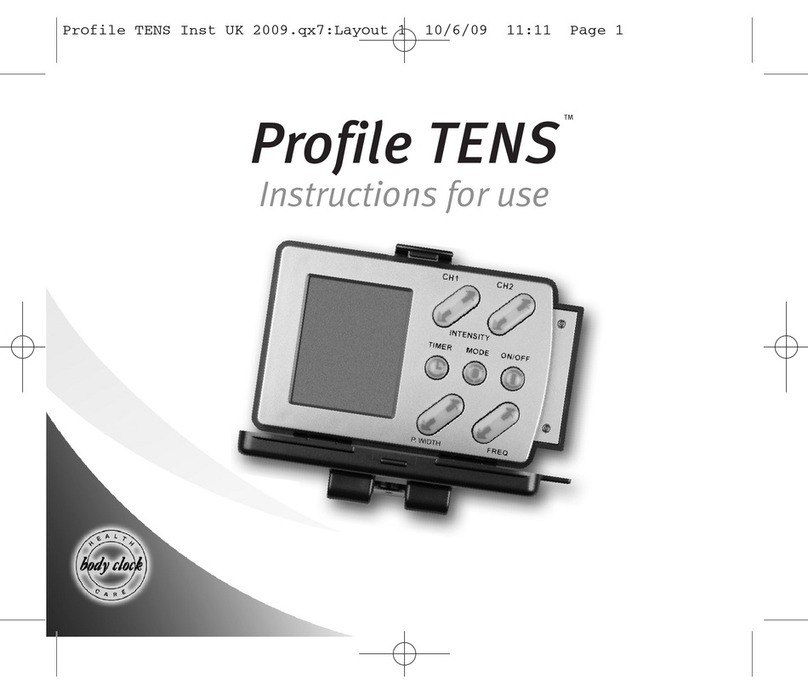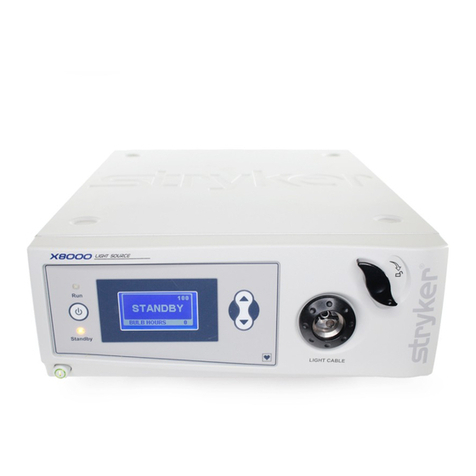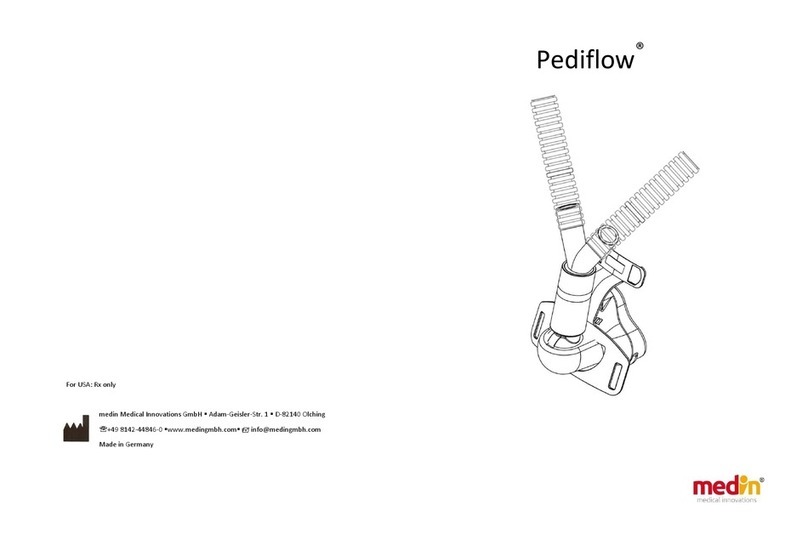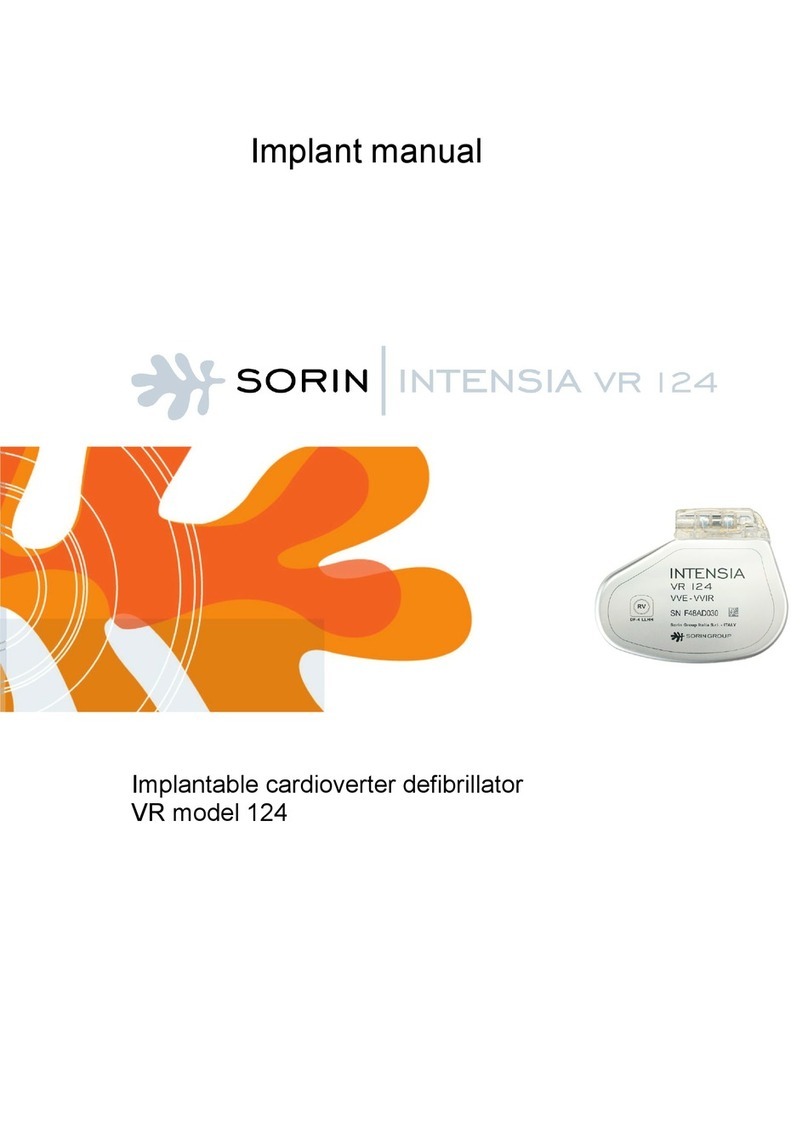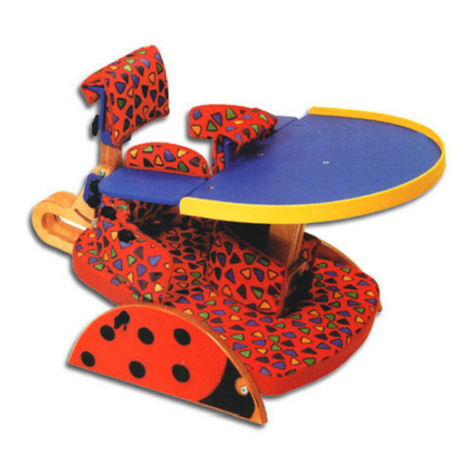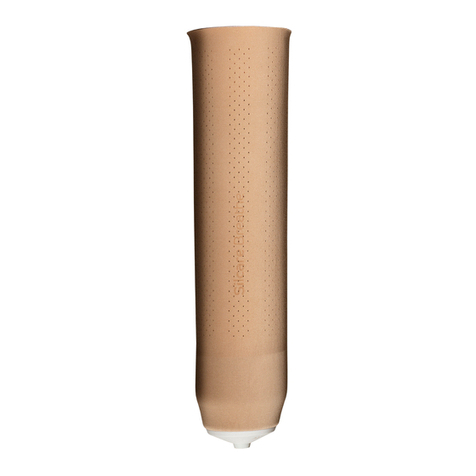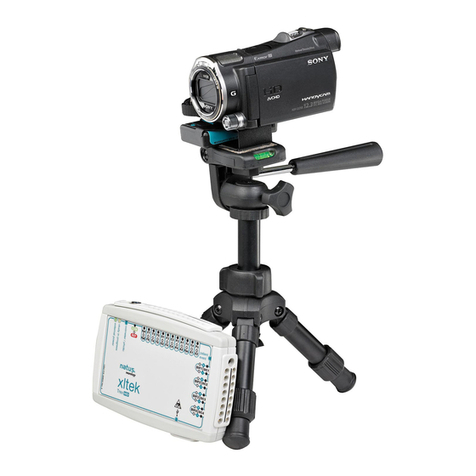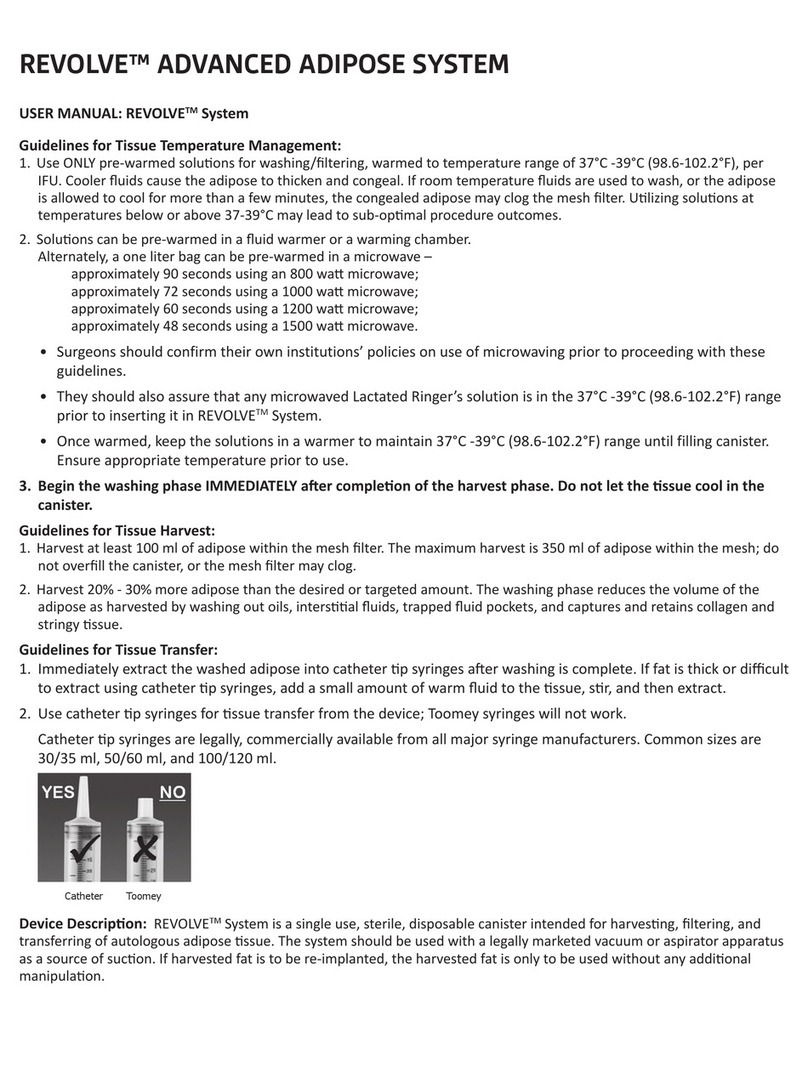Grafco GF-TX5 User manual


CONTENTS
It is recommended that you read this entire
manual thoroughly before using your GF-TX5
stimulator.
Introduction
Cautions
Warnings
General Description
Construction
Technical Specifications
Accessories
Attachment of Electrode Lead Wires
Lead Wire Maintenance
Electrode Placement
Tips For Skin Care
Application of Re-useable Self
Adjusting the Controls
Operating Instruction
After Use
Removing Electrodes/ Lead wires
Maintenance, Transportation and
Safety-Technical Control
Trouble Shooting
Malfunctions
Service/ Repair
Warranty
1
3
4
5
6
7
9
10
12
13
17
18
20
24
26
27
.....................................
.........................................
.........................................
..........................
.....................................
....................
.....................................
....
.....................
.........................
............................
............
.......................
........................
....................
..............................
....................................
................................
.........................................
........................................
........
29
30
31
31
32
28

pain perception. T.E.N.S. does not cure any
physiological problem; it only helps control the
pain. T.E.N.S. does not work for everyone;
however, in most patients it is effective in
reducing or eliminating the pain, allowing for a
return to normal activity.
How T.E.N.S. works ?
There is nothing "magic" about Transcutaneous
Electrical Nerve Stimulation (T.E.N.S.). T.E.N.S.
is to be used to relieve pain. The T.E.N.S. unit
sends comfortable impulses through the skin
that stimulate the nerve (or nerves) in the
treatment area. In many cases, this stimulation
will greatly reduce or eliminate the pain sensation
the patient feels. Pain relief varies by individual
patient, mode selected for therapy, and the type
of pain. In many patients, the reduction or
elimination of pain lasts longer than the actual
period of stimulation (sometimes as much as
three to four times longer). In others, pain is
only modified while stimulation actually occurs.
You may discuss this with your physician or
therapist.
21
INTRODUCTION
What is Pain ?
Pain is a warning system and the body's method
of telling us that something is wrong. Pain is
important; without it abnormal conditions may
go undetected, causing damage or injury to
vital parts of our bodies.
Even though pain is a necessary warning signal
of trauma or malfunction in the body, nature
may have gone too far in its design. Aside
from its value in diagnosis, long-lasting
persistent pain serves no useful purpose. Pain
does not begin until a coded message travels
to the brain where it is decoded, analysed, and
then reacted to analyzed. The pain message
travels from the injured area along the small
nerves leading to the spinal cord. Here the
message is switched to different nerves that
travel up the spinal cord to the brain. The pain
message is then interpreted, referred back and
the pain is felt.
What is T.E.N.S. ?
Transcutaneous Electrical Nerve Stimulation is
a non-invasive, drug-free method of controlling
pain. T.E.N.S. uses tiny electrical impulses
sent through the skin to nerves to modify your

WARNINGS
1) Caution should be used in applying T.E.N.S.
to patients suspected of having heart disease.
Further clinical data is needed to show there
are no adverse results.
2) Electrical stimulation safety has not been
established during pregnancy. Do not use
T.E.N.S. during pregnancy.
3) Do not place electrodes on the front of the
throat as spasm of the Laryngeal and
Pharyngeal muscle may occur. Do not
stimulate over the carotid nerve, particularly
with patients with known sinus reflex
sensitivity.
4) Care should be taken so that when operating
potentially dangerous machinery the
stimulator controls are not changed abruptly.
5) Cases of skin irritation at the electrode site
have been reported. Stimulation should be
stopped and electrodes removed until the
cause of the irritation is determined.
6) Electrodes should not be placed over the
eyes, in the mouth, or internally.
7) Keep this device out of the reach of children.
43
CAUTIONS
1) Read operation manual before use of
T.E.N.S..
2) We emphasize that any patient with an
implanted electronic device (for example, a
pacemaker) should not undergo T.E.N.S.
treatment without first consulting a doctor.
The same applies to patients with any
metallic implants.
3) If T.E.N.S. therapy becomes ineffective or
unpleasant, stimulation should be
discontinued until its use is re-evaluated by
the physician or therapist.
4) Avoid adjusting controls while operating
machinery or vehicles.
5) Turn the T.E.N.S. off before applying or
removing electrodes.
6) The devices have no AP/APG protection.
Do not use it in the presence of explosive
atmosphere and flammable mixture.

CONSTRUCTION
65
GENERAL DESCRIPTION
The GF-TX5 is a battery operated pulse
generator that sends electrical impulses to
electrodes to the body and reach the nerves
causing pain. The device is provided with two
controllable output channels, each independent
of each other. An electrode pair can be
connected to each output channel.
The electronics of the GF-TX5 create electrical
impulses whose Intensity, duration, number per
second and modulation may be altered with
the controls/switches. Push-buttons are very
easy to use and the large liquid crystal display
showing the exact mode and values of
parameters are very convenient for patients.
Channel I ON/OFF
and Amplitude Control
Channel II ON/OFF
and Amplitude Control
Channel I
Output Indicator
Output Mode
Pulse Width
Pulse Rate
Timer
Channel II
Output Indicator
Battery Indicator
Unit
Increase
Decrease
Setting Value
Parameter Select
Mode Select
Channel I
Output Receptacle
Channel II
Output Receptacle Belt Clip
9 Volt Battery

Display : Showing all chosen
function and indicating
the condition of the
battery
Timer : 1-60 min. (1min./step)
Treatment memory : Memory of the last
treatment setting
Low battery indicator :indicates symbol by
weakness of the battery
Size : 95 x 60 x 25 mm
Weight : 90 grams without battery
Remark : There may be up to a
+/- 10 % tolerance of all
specifications.
87
TECHNICAL SPECIFICATIONS
The technical specification details of GF-TX5
are as follows.
Power source : One - 9 volt DC battery
(alkaline recommended)
Channel : Dual, isolated between
channels
Output voltage : Adjustable, from 0 to 40V
(Max. output), 500 ohm
load
Output inT.E.N.S.ity : Adjustable, 0-80 mA
(Max. output) 500 ohm
load
Pulse rate : Adjustable, from 1 to150
Hz, 45 adjustable
frequencies
Pulse width : Adjustable, from 30 uS
to 300 uS
Wave form : Asymmetrical bi-phasic
rectangular pulse
Treatment mode : 5 therapeutical modes
B mode : PW/Timer adjustable
M mode : PR/PW/Timer adjustable
C mode : PR/PW/Timer adjustable
A mode : PR/PW/Timer adjustable
S mode : PR/PW/Timer adjustable
I
I

ATTACHMENT OF
ELECTRODE LEAD WIRES
1) Connect the wire and main unit
The wires provided with the system insert into
the jack sockets located on right side of the
device. Holding the insulated portion of the
connector, push the plug end of the wire into
one of the jacks (see drawing); one or two sets
of wires may be used.
2) Electrode lead wires
The use of the electrically conductive medium
is subject to the specifications of the component
parts contained in the unit or recommended by
the dealer.
109
ACCESSORIES
Each set GF-TX5 is complete with:
1) Adhesive electrodes 4 pieces
2) Electrodes leads 2 pieces
3) 9 VDC battery 1 piece
4) Instruction manual 1 piece
5) Carrying case 1 piece
6) Replacement electrodes
ITEM 9260
2" Pre-Gelled T.E.N.S. electrodes
Output plug
(plugs into
output receptacle)
Pin Connectors
(plugs into electrodes)
(neg)
(pos)
Electrode
Electrode Pin Socket

LEAD WIRE MAINTENANCE
Clean the wires by wiping with a damp cloth.
Coating them lightly with talcum powder will
reduce tangling and prolong life.
1211
3) Connect the wire and electrode
After connecting the wires to the stimulator,
attach each wire to an electrode. Use care
when you plug and unplug the wires. Jerking
the wire instead of holding the insulated
connector body may cause wire breakage.
Caution :
Do not insert the plug of the patient lead
wire into the AC power supply socket.

Contiguous placement :
This is the most common placement technique.
It involves placing the electrodes alongside the
area of localized pain site, in such a way as to
direct the flow of current through or around the
area of pain.
In a single channel application, this would
involve placing each pad on either side of the
pain site if the pain is localized on a limb and
deep within the tissue. Pad placement on the
posterior and anterior aspects of the affected
limb will allow the current to flow completely
through the limb and thus through the
endogenous pain site.
With a two channels application, the clinician
may either direct the current flow to cross
through the pain site or, in what is called the
"bracket" method allowing the current flow on
either side of the painful area, generally through
the nerve branches that feed into the pain site.
Dermatomes, myotomes and sclerotomes :
These are the regions of the body enervated
by one spinal nerve. Electrode placement
involves both stimulating across the similarly
1413
ELECTRODE PLACEMENT
The placement of electrodes can be one of
the most important parameters in achieving
success with T.E.N.S. therapy. Of utmost
importance is the willingness of the clinician
to try the various styles of electrode placement
to find which method best fits the needs of the
individual patient.
Every patient responds to electrical stimulation
differently and their needs may vary from the
conventional settings suggested here. If the
initial results are not positive, feel free to
experiment. Once an acceptable placement
has been achieved, mark down the electrodes
sites and the settings on the patient's Reference
Sheet of this manual, so the patient can easily
continue treatment at home.
Left Side Rear View Right Side
Mark your electrode placement (s) here.

stimulate the pain site in a contiguous manner;
the other channel can be placed along the
involved dermatome or utilized for point therapy.
1615
enervated area and/or placing one electrode
(or set of electrodes) at the pain site and
another electrode (set) at the point where the
nerve root joins the spinal cord.
Motor, trigger and acupuncture points :
While these points of high tissue conductivity
can differ in location and in theory of use, their
use as an electrode site is identical. The
easiest technique involves placing one pad
directly over the point and completing the
circuit by placing the second pad on some area
on the affected side. This second electrode
site can be within a nerve zone, or a master
point located between the thumb and the
forefinger on the dorsal web area between the
two metacarpal bones.
Multiple placement strategies :
Because the T.E.N.S. has two independently
operated channels, the clinician may take
advantage of concurrent pad placement
strategies.
For example, it is possible to use two different
electrode placement strategies at the same
time. One channel can be used to directly

APPLICATION OF RE-USEABLE
SELF ADHESIVE ELECTRODES
Application :
1) Clean and dry the skin at the prescribed
area thoroughly with soap and water prior
to application of electrodes.
2) Insert the lead wire into the pin connector
on the pre-wired electrodes.
3) Remove the electrodes from the protective
liner and apply the electrodes firmly to the
treatment site.
Removal :
1) Lift at the edge of electrodes and peel; do
not pull on the lead wires because it may
damage the electrodes.
2) Place the electrodes on the liner and remove
the lead wire by twisting and pulling at the
same time.
Care and Storage :
1) Between uses, store the electrodes in the
resealed bag in a cool dry place.
2) It may be helpful to improve repeated
application by spreading a few drops of cold
water over the adhesive and turn the surface
up to air dry. Over Saturation with water will
reduce the adhesive properties.
1817
TIPS FOR SKIN CARE
To avoid skin irritation, especially if you have
sensitive skin, follow these suggestions:
1) Wash the area of skin where you will be
placing the electrodes, using mild soap and
water before applying electrodes, and after
taking them off. Be sure to rinse soap off
thoroughly and dry skin well.
2) Excess hair may be clipped with scissors;
do not shave stimulation area.
3) Wipe the area with the skin preparation your
clinician has recommended. Let this dry.
Apply electrodes as directed.
4) Many skin problems arise from the "pulling
stress" from adhesive patches that are
excessively stretched across the skin during
application. To prevent this, apply electrodes
from center outward; avoid stretching over
the skin.
5) To minimize "pulling stress", tape extra
lengths of lead wires to the skin in a loop to
prevent tugging on electrodes.
6) When removing electrodes, always remove
by pulling in the direction of hair growth.
7) It may be helpful to rub skin lotion on
electrode placement area when not wearing
electrodes.
8) Never apply electrodes over irritated or
broken skin.

ADJUSTING THE CONTROLS
Caution for digital device:
When the device on, it take approx 5 seconds
for IC reset. If you switch ON and OFF too
quickly, the device will not work. When changing
the battery,the device should be OFF.
The GF-TX5 can be easily adjustable to your
comfort and relief of your pain by two intensity
control knobs. The output of the stimulator may
decrease slightly as the battery wears down.
If you sense no stimulation, check the battery
as well as the cables, making sure they are
properly inserted.
If you receive no pain relief, consult your
clinician for electrode placement or stimulation
mode alternatives.
1) Slide Cover
A slide-on panel covers the buttons controlling
pulse width, pulse rate and modes. Your
clinician may wish to set these controls for you
and request that you leave the cover in place.
2) Power On/Off Switch and Intensity
Control
Turn knobs- top of unit. If both turn knobs are in
the OFF - position - the device is switched OFF.
2019
Important :
1) Do not apply to broken skin.
2) The electrodes should be discarded when
they are no longer adhering.
3) The electrodes are intended for single
patient use only.
4) If irritation occurs, discontinue use and
consult your clinician.
5) Read the instruction for use of self-adhesive
electrodes before application.

5) Pulse Rate Control
Pulse rate is adjustable. Its value is visible on
the LCD. This buttons determine how many
electrical impulses are applied through the skin
every second. By pressing these controls, the
number of current impulses per second (Hz)
for both channels can be continually adjusted.
Unless otherwise instructed, turn the pulse
rate control to the 70-120 Hz range.
Increase Button
When pressing this button, the pulse rate will
increase gradually.
Decrease Button
When pressing this button, the pulse rate will
decrease gradually.
6) Pulse Width Control
Pulse Width is adjustable. Its value is visible
on the LCD. These buttons adjusts the length
of time each electrical signal is applied through
the skin, which controls the strength and
sensation of the stimulation. If no instructions
regarding the pulse width are given in therapy,
set the control to the suggested 70-120 uS
setting.
Increase Button
When pressing this button, the pulse width will
increase gradually.
2221
By turning the controls clockwise, the power
will be switched On. A symbol will be revealed
on the LCD as soon as the stimulation is
commenced.
The current strength of the impulses transmitted
to the electrodes increases further when the
control is turned clockwise. To reduce the
current strength or switch the device Off, turn
the control counter clockwise to the required
setting or Off-position, respectively.
3) Lead Connector
Connection of the electrodes are made with a
two-lead connector. The device must be turned
Off before connecting the cables. Both intensity
controls must be at the OFF position.
Electrodes must be pressed firmly on the skin.
4) Mode Control
Expose the controls by sliding front cover down
from middle of unit. This button operates 5
modes:
Bfor burst stimulation.
Mfor modulation stimulation.
Cfor constant stimulation (Normal).
Afor intensity and pulse rate modulation.
Sfor intensity and pulse width modulation.
Press the button until the unit is in the mode
desired.
I

OPERATING INSTRUCTION
1) Turn the device "On" by turning channel 1
or channel 2 amplitude knobs located on
the top of the unit clockwise.
2) Push the top slide cover from up to down to
expose the Mode control section.
3) Mode Control : Choose the output mode by
press MODE (B,M,C,A&S) key. The five
therapeutical mode will show up from one
to another and rotate accordingly.
4) The PW/PR/Timer control : Press the SET
key to adjust these 3 functions. When press
the SET key, the 3 functions will show up
from one to another and rotate accordingly.
5) The LCD panel will display :
PW From 30 to 300uS, with 10uS/step.
PR From 1 to 150 Hz, with 45 levels.
Timer From 1 to 60 minutes, with 1 min./step.
The display will show PR, then PW, then,
Timer. To adjust these 3 functions by using
the and keys. The digit number goes
from one digit to the next digit, increase or
decrease.
6) Setting Value : Press the or over 1
second, the digital numbers will increase /
decrease rapidly.
7) Battery power indicator :
full-scale battery, power full
half-scale battery, power low
2423
Decrease Button
When pressing this button, the pulse rate will
decrease gradually
7) The device will store the mode that is
used before it is switched oFF
automatically.
8) Check/ Replace the Battery
Over time, in order to ensure the functional
safety and effectiveness of T.E.N.S., it is
necessary to change the battery.
" "Full-scale battery, power full
" "Half-scale battery, power low
8.1) Make sure that both intensity controls are
switched to the Off position.
8.2) Slide the battery compartment cover and
open.
8.3) Remove the battery from the compartment.
8.4) Insert the battery into the compartment.
Note the polarity labels, (+ and -), on the
battery and in the compartment and insert
accordingly.
8.5) Replace the battery compartment cover
and press to close.
II

AFTER USE
1) Turn the intensity control OFF
Turn the intensity control in anticlockwise to
OFF.
2) Disconnect wire and electrode
Pull out the wire from the output jack. Leave
the electrode on the skin if another treatment
is going to start with severel minutes. After a
treatment session is finished, take off the
electrode and clean your skin.
2625
7) Battery power indicator :
full-scale battery, power full
half-scale battery, power low
8) Adjust channel amplitude :
Turn channel 1 or 2 clockwise. The indicator
will light up as long as the unit is in stimulation.
Slowly turn the channel control in a clockwise
direction until you reach the setting
recommended by your clinician. Repeat for the
other channel, if both channels are to be used.
Indicator light will blink at lower pulse rate
setting or keep solid when the pulse rate
setting is high. The display will show the output
current in mA when the channel amplitude is
adjusted.
Note : the number / function reads on the
display will be the last number / function
adjusted.
9) Time memory control :
Read total treatment time : Press the MODE+
key to read total treatment time.
Reset the timer recording to zero : Press the
MODE+ key to reset the timer record.
10) Parameters reset control : Press and hold
the Mode key before you turn on the unit.

MAINTENANCE, TRANSPORTATION
AND STORAGE OF T.E.N.S. DEVICE
1) Non-flammable cleaning solution is suitable
for cleaning the device.
Note : Do not smoke or work with open lights
(for example, candles, etc.) or while working
with flammable liquids.
2) Stains and spots can be removed with a
cleaning agent.
3) Do not submerge the device in liquids or
expose it to large amounts of water.
4) Return the device to the carrying box with
sponge foam to ensure that the T.E.N.S.
unit is well-protected before transportation.
If the device is not to be used for a long
period of time, remove the batteries from
the battery compartment (acid may leak
from used batteries and may damage the
device). Put the device and accessories in
carrying box and store it in cool dry place.
5) The T.E.N.S. device should be stored and
transported under the temperature range
of -20 C ∼+ 60 C, relative humidity 20%
∼ 95%, atmosphere pressure 500 hPa ∼
1060 hPa.
2827
REMOVING ELECTRODES/
LEADWIRES
It is strongly recommended to leave the lead
wires plugged into the unit to lessen the
possibility of breakage. If it is necessary to
unplug them, turn both Channel controls to
"O" OFF. Unplug by grasping them by the plug
and pull straight up. Do not twist. If treatment
will be resumed shortly, the electrodes may
be left on the skin. When the electrodes are
removed, clean the skin thoroughly with soap
and water. If there is skin irritation, consult
your medical professional.
When the LCD becomes dim, it means the
battery should be replaced with a new one as
soon as possible. However the stimulator will
continue to operate for a few more hours.
。 。

TROUBLE SHOOTING
If your GF-TX5 appears to be functioning
improperly, use the chart below to determine
what may be wrong.
LCD Indicator lights ON but unit does not
function properly:
1) Check control settings. Are they set as
prescribed by your medical professional?
2) Are electrodes in proper position?
3) Check lead wires. Make sure all connectors
are firmly seated.
4) Replace lead wires with another to check
for broken wires.
LCD light dim & Battery power indicator
shows half-scale:
Replace battery with a new one.
No LCD indicator lights on:
Replace battery with a new one.
If none of these measures correct the problem,
the unit should be serviced.
3029
SAFETY-TECHNICAL CONTROLS
For safety reasons, check your unit each week
based on the following checklist.
1) Check the device for external damage.
Deformation of the housing.
Damaged or defective output sockets.
2) Check the device for defective operating
elements.
Legibility of inscriptions and labels.
Make sure the inscriptions and labels are
not distorted or removed.
3) Check the usability of accessories.
Patient cables are undamaged.
Electrodes are undamaged.
Please consult your dealer/ distributor if there
are any problems with device and accessories.

WARRANTY
All GF-TX5 devices carry a warranty of one
year from the date of delivery. The warranty
applies to the stimulator only and covers both
parts and labor relating thereto.
The warranty does not apply to damage
resulting from failure to follow the operating
instructions, accidents, abuse, alteration or
disassembly by unauthorized personnel.
CAUTION : FEDERAL LAW (U.S.A)
RESTRICTS THIS DEVICE TO SALE BY OR
ON THE ORDER OF A PHYSICIAN.
3231
MALFUNCTIONS
Should any malfunctions occur while using the
GF-TX5, check
1) whether the parameters are set to the
appropriate form of therapy. Adjust the
control correctly.
2) whether the cable is correctly connected to
the device. The cables should be inserted
completely into the sockets.
3) whether the LCD reveal the menu. If
necessary, insert a new battery.
4) for possible damage to the cable. Change
the cable if any damage is detected.
If there is any other problem, please return the
device to your distributor. Do not try to repair a
defective device.
SERVICE/REPAIR
To obtain service, contact your dealer for
instructions.

33
Manufactured for :
Graham-Field Health Products.
Atlanta GA 30360
Made in Taiwan
www.grahamfield.com
Other manuals for GF-TX5
1
Table of contents
Other Grafco Medical Equipment manuals
Popular Medical Equipment manuals by other brands

Hospira
Hospira Plum A+ operating manual
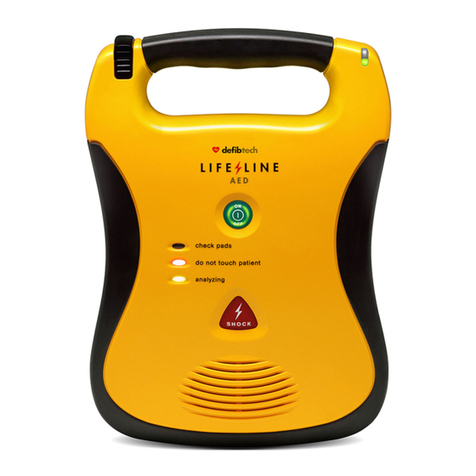
Defibtech
Defibtech Lifeline/ReviveR DDU-100 operating guide
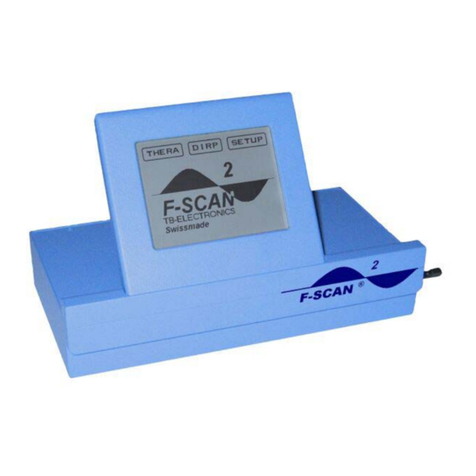
TB-Electronics
TB-Electronics Frequency Synthesizer F-SCAN2 instruction manual
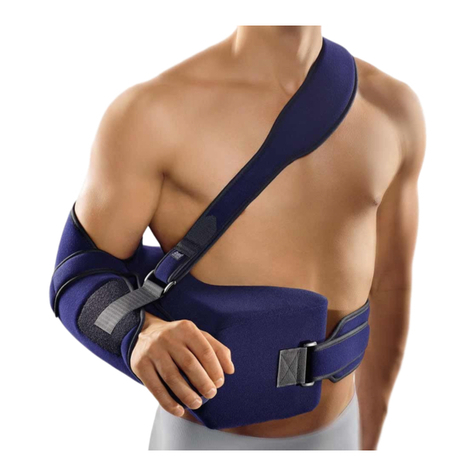
bort medical
bort medical OmoARS quick guide
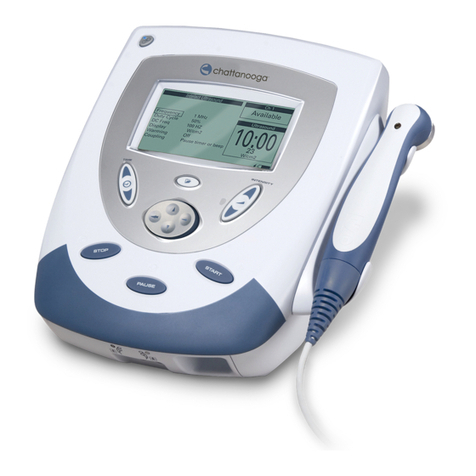
Chattanooga
Chattanooga Intelect Mobile Ultrasound user manual
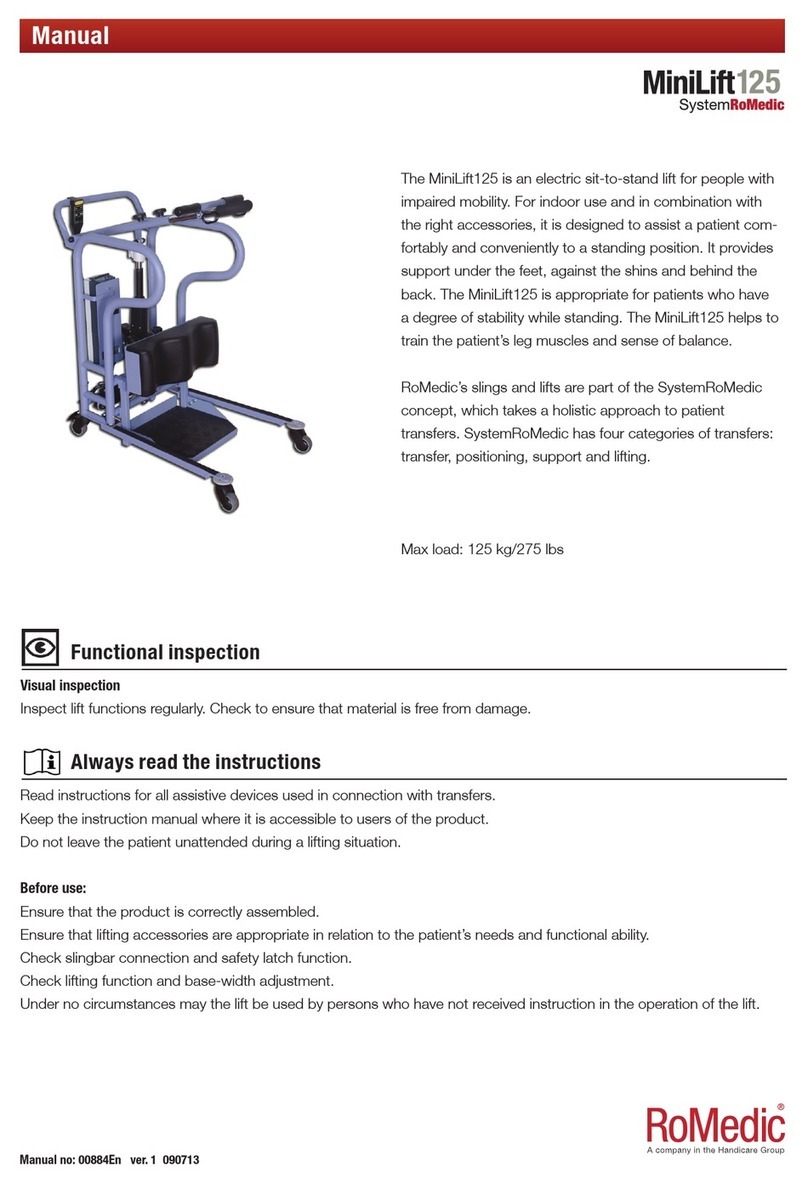
RoMedic
RoMedic MiniLift125 instructions
